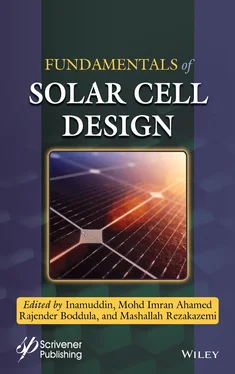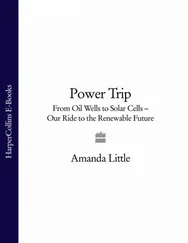1.4.4 Power Conversion Efficiency η p(PCE)
It is a measure of the quality of the cell which provides evidence of how much power the cell will generate per incident photon. The efficiency η pis the maximum electrical power P maxper light input P L.

The FF, which determines the quality of solar cell can be obtained from the ratio of the maximum power output to the product of its Voc and Jsc and is always < 1.

1.5 Some Basic Design Principles/Thumb Rules Associated With Organic Materials Required for BHJOSCs
The donor and acceptor molecules to be employed in BHJOSCs must have light absorption property matching the solar region, with high molar absorption coefficients and excellent width at half height of absorption spectrum. It would be best if absorption ranges of donor and acceptor materials are complementary.
The HOMO/LUMO energy levels of molecules should be well matched for the possible photochemical electron transfer between acceptor and donor molecules.
To obtain high open-circuit voltage (VOC), a deep HOMO level is to be adjusted, since maximum value of the VOC is determined by the energy difference between the HOMO level of the donor and LUMO level of the acceptor.
Balanced charge (negative and positive) mobility of the organic blend materials is required for controlled charge transport.
Good solubility of blend organic materials is essential for good film forming property and well mixing with acceptor materials to form nanoscale phase separation and ideal blend morphology.
Suitable recognition points may be introduced in blend materials, such that they can involve in forming supra-molecular structures leading to well organized film morphology, altered UV-visible absorption and providing good charge transport property.
Blend materials, higher thermal stability, and their phase transition temperature data are to be tuned properly.
1.6 Recent Research Advances in Small-Molecule Acceptor and Polymer Donor Types
Research on BHJ organic solar cells resulting from fullerene as acceptor is dealt at length for the past several years. During the course of investigations by many researchers, it was found that fullerene has limitations in using it as acceptor in solar cell devices. The shortcomings or limitations with properties of fullerene are like negligible light absorption in NIR and visible region, shape of the molecule, solubility, controlling the film texture or film morphology, stability of fullerene, and very limited tunability of energy levels of fullerene. These limitations lead the researchers to explore novel materials to initiate work on non-fullerene derived acceptors for BHJ organic solar cells to replace fullerene and take the system to improve efficiency of organic solar cells. The following part describes BHJOSCs involving non-fullerene acceptors with polymer donors.
Dongxue Liu et al. reported two low band gap acceptor materials where in, linearly fused 6 five membered rings having four “Sulfur” atoms in the ring structure acted as donor central core moiety and the remaining part as acceptor at both sides ( Figure 1.4) [1]. Thiophene and selenophene moieties are embedded as π-spacers to improve conjugation and also for intra-molecular charge transfer (ICT) leading to red shift in the absorption spectrum. But this thiophene or selenophene insertion did not affect the HOMO-LUMO values of the small acceptor molecules, 4TO-T-4F and 4TO-Se-4F. Two end groups with electron withdrawing nature, 2-(5,6-difluoro-3-oxo-2-2,3-dihydro-1H-inden-1-ylidene)malononitrile, helped in enhancing ICT. The optical band gaps estimated for 4TO-T-4F and 4TO-Se-4F were 1.3 and 1.27 eV, respectively. Optical, thermal, and electrochemical properties determined were found to be suitable as non-fullerene acceptors. Polymer PTB7-Th was used as donor, and the other two, 4TO-T-4F and 4TO-Se-4F, acted as non-fullerene smallmolecule acceptors in organic solar cell fabrications and the configuration of the cell was: IndiumTinOxide/ZnO/[Donor-PTB7-Th:Acceptor]blend/ MoO3/Ag. Solar cell performance was determined as 8.7% (PCE) for 4TO-T-4F with loss of energy of 0.55 eV and 7.4% (PCE) for 4TO-Se-4F with loss of energy of 0.57 eV.
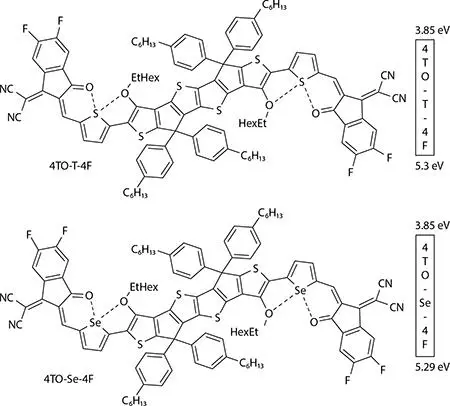
Figure 1.4 Vinylidine dicyano–difluoroindanone compounds.
Benzothiadiazole central ring fused with pyrrole and bithiophene rings on both sides (seven rings contiguously fused together) and carrying electron withdrawing end groups 2-(5,6-difluoro-3-oxo-2-2,3-dihydro-1H-inden-1-ylidene)malononitrileand2-(5,6-dichloro-3-oxo-2-2,3-dihydro-1H-inden-1-ylidene)malononitrile was the main core designed and developed ( Figure 1.5) by Yong Cui et al. for organic solar cells as low band gap organic materials [2]. Various techniques like UV-Vis-NIR absorption, fluorescence, thermal, electrochemical, AFM, TEM, and GIWAXS characterizations (morphology of films) as well as computational, X-ray diffraction (molecular packing), charge carrier mobility, TPV measurements, and highly sensitive EQE and EQEEL measurements were applied to generate the data. OPV fabrications were conducted using PBDB-TF as donor and BTP-4F and BTP-4Cl as non-fullerene acceptors. OPV cells were fabricated with an inverted configuration of Indium Tin Oxide/ZnO nano-particles/[donor polymer PBDB-TF:BTP-4X] blend/MoO3/Al, where PBDB-TF polymer was selected as electron donor material. Photo-conversion efficiency determined from solar cell fabrications was 15.6% for BTP-4F and 16.5% for BTP-4Cl with 0.834 and 0.867 V, respectively. The high PCE was attributed to the chlorine effect by reducing the non-radiative energy (~0.26 eV) loss. Further, it is expected that fine tuning the low band gap material properties has a great potential to achieve higher conversion efficiencies.
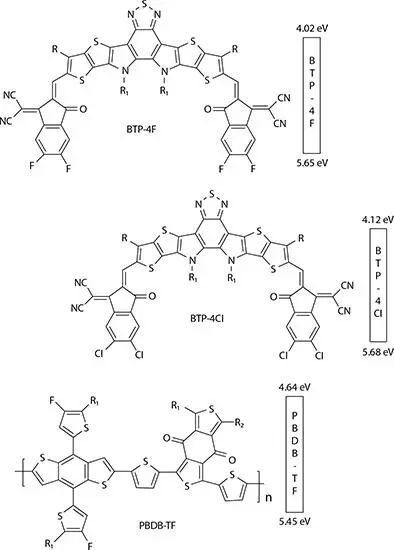
Figure 1.5 Fused benzo-thiadiazole–dicyanoindenone compounds.
Bin Kan et al. described the synthesis of small-molecule donor NCBDT-4Cl (ADA type) with ~1.40 eV optical band gap and used it for solar cell fabrication along with polymer (non-fullerene) acceptor PBDB-T-SF ( Figure 1.6) [3]. The NCBDT-4Cl (ADA type) donor and acceptor PBDB-T-SF blend provided 300- to 900-nm range absorption with very good molar absorption co-efficient. Solution processed solar cells were constructed with the given cell configuration: ITO/polymer PEDOT-PSS/polymer PBDB-T-SF:NCBDT-4Cl/PDINO/Al—where in PDINO acted as electron transport layer. Fabricated device as casted (without any treatment) produced efficiency of PC 13.1%. The same device after annealing and solvent addition, gave a result of PCE 14.1% along with Voc of 0.85V, Jsc of 22.35 mA cm −2and accompanied by loss of energy of 0.55 eV. Authors attributed the excellent display of 14.1% PC efficiency to the blend morphology as well as to the excellent charge transport property due to attached four chlorine atoms in NCBDT-4Cl (ADA type) donor at appropriate places.
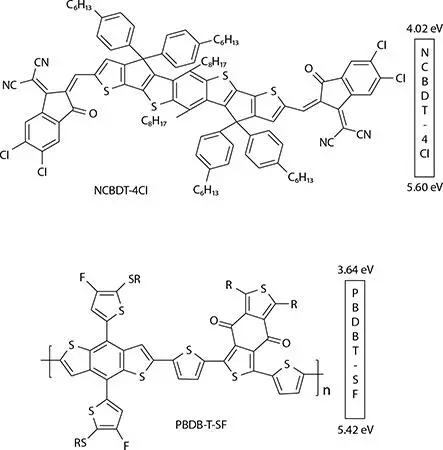
Figure 1.6 Fused seven rings with dicyanoindenone end groups.
Читать дальше
